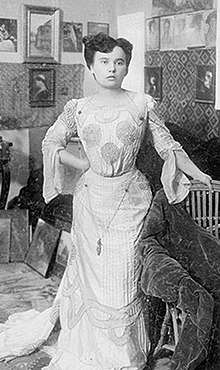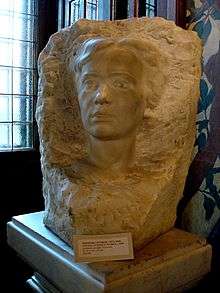Cecilia Cuțescu-Storck
Cecilia Cuțescu-Storck (14 March 1879, Câineni, Vâlcea – 29 October 1969, Bucharest) was a Romanian painter with a strong influence on cultural life in the interwar period. She was a promoter of Feminism, contributing to the establishment of the "Association of women painters and sculptors" (together with Olga Greceanu and Nina Arbore) and "Feminin artistic circle".


Biography
Cecilia Cuțescu was born in the village Râul Vadului, in the Câineni commune. She was adopted by her maternal grandparents, from which she has the name Cuțescu. She remained however very close to her parents, Natalia and Ion Brăneanu, and her sisters, Fulvia – who died in her teen years – and Ortansa – who became an important feminist activist in Romania.
She began studies at Damenakademie, Munich, in 1897. In 1899 she leaves for Paris, taking classes at Academie Julien. Her paintings are introduced to the public through exhibitions held in France and Romania.
Distinctions
- Medalia de aur si Marele premiu la Expoziția Internațională de la Barcelona (1929)
- Cavaler al Ordinul Meritul Civil, Spania (1930)
- Cavaler al Legiunii de Onoare, Franța (1933)
- Medalia de aur la Expoziția Internațională de la Paris (1937)
- Maestru Emerit al artei în 1957, pentru întreaga activitate artistică.[1]
Authored books
- Fresca unei vieți, Bucovina, Editura Torouțiu, 1943
- O viață dăruită artei, Editura Meridiane, 1966
- Fresca unei vieți, Editura Vremea, București, 2006
Referenced in books
- Leon Thevenin: Cecile Coutesco-Storck, sa vie et son oevre, Quatre Chemins, 1932
- Angela Vrancea: Cecilia Cuțescu-Storck, Editura de Stat pentru Literatură și Artă, 1957
- Gabriela Storck și Petre Comarnescu: Cecilia Cuțescu-Storck: Expozitie Retrospectiva, Uniunea Artiștilor Plastici, 1959
- Marin Mihalache: Cecilia Cuțescu-Storck, Editura Meridiane, București, 1969
- Liliana Vârban, Ionel Ionița, Dan Vasiliu: Casa Storck – Muzeul Storck, Muzeul Municipiului București, 2005
- Jeremy Howard: East European Art, Oxford University Press, 2006
- Shona Kallestrup: Art and Design in Romania 1866–1945, Columbia, Eastern European Monographs, 2006
- Aurora Liiceanu: Patru femei, patru povești, Editura Polirom, 2010
In memoriam
In June 2010, from the initiative of the rector of the Economic Studies Academy of Bucharest, Gheorghe Roșca, and of the mayor of Câineni, Ion Nicolae, a commemorative plaque was placed in the village Râul Vadului.[2]
The Frederic and Cecilia Cuțescu-Storck Art Museum is a modern art museum located in Bucharest, Romania, dedicated to the painter and her husband.
References
- O listă completă se află în monograful Cecilia Cuțescu-Storck de Marin Mihalache (Editura Meridiane, București, 1969)
- "Pictorița Cecilia Cuțescu-Storck, comemorată la Câineni". Archived from the original on 24 June 2016. Retrieved 25 May 2016.
Bibliography
- Cecilia Cuțescu-Storck: Fresca unei vieți, Bucovina, Editura Torouțiu, 1943
- Gabriela Storck si Petre Comărnescu: Cecilia Cuțescu-Storck: Expozitie Retrospectiva, Uniunea Artiștilor Plastici, 1959
- Marin Mihalache: Cecilia Cuțescu-Storck, Editura Meridiane, București, 1969
- Liliana Vârban, Ionel Ionița, Dan Vasiliu: Casa Storck – Muzeul Storck, Muzeul Municipiului București, 2005
- Shona Kallestrup: Art and Design in Romania 1866–1945, Columbia, Eastern European Monographs, 2006
External links
| Wikimedia Commons has media related to Cecilia Cuțescu-Storck. |
- Biography of Cecilia Cuțescu-Storck
- http://metropotam.ro/La-zi/2007/01/art7087336963-Muzee-din-Bucuresti-Casa-Storck/
- http://artistiromani.wordpress.com/2008/07/27/cecilia-cutescu-storck-1879-1969/
- http://bucharest.romaniaexplorer.com/page_10865.html
- Vă mai amintiți de: Cecilia Cuțescu-Storck, 1 februarie 2011, Eliza Zdru, Adevărul